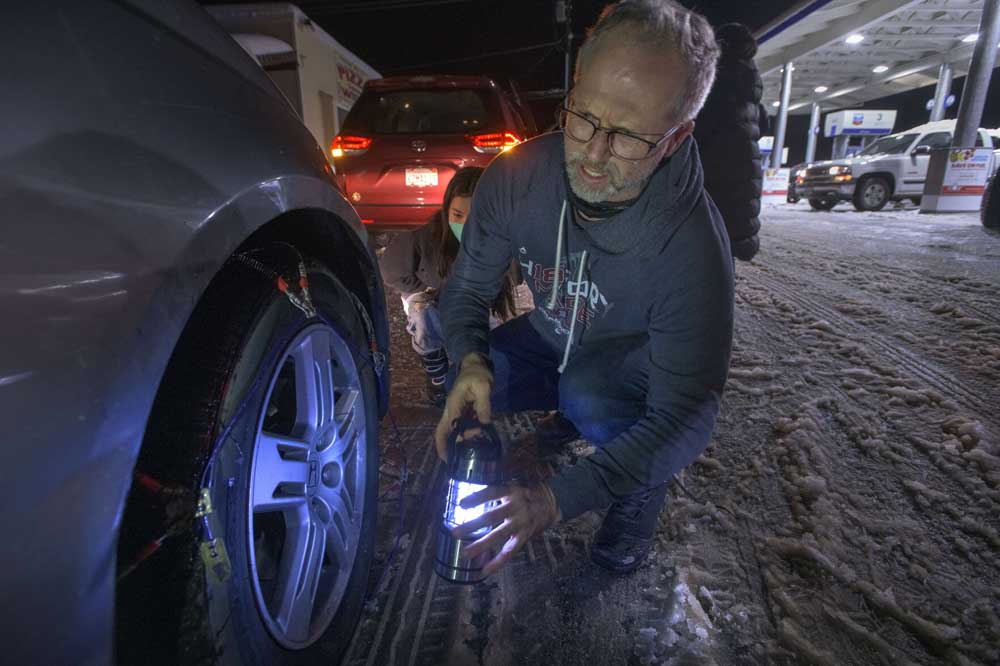Get a grip on winter driving
Published 11:37 am Thursday, December 8, 2022

- FILE- Rob Hager, of Redwood City, California, removes tire chains from his car at a roadside gas station in Camino on in 2021. Hager and his family spent over five hours in stopped traffic along U.S. Highway 50. They were headed east to the Lake Tahoe are for skiing but gave up and returned home.
Many in Redmond, especially skiers and boarders and others who thrive on cold weather activities, hope for big winter storms that dump snow on our mountains and cities.
And while winter storms are good for winter recreation and summer agriculture, they can be dangerous for drivers.
Already a good number of motorists have switched over to their winter tires or studded tires, the latter seemingly annoying some Redmonders due to the noise and perceived damage to the roads. Even drivers using studs admit that cabin noise from the studs can be a nuisance.
In fairness, technology has improved on this front. Some studded tire makers install a soft rubber layer between the stud base and tire surface, acting like a spring and dropping decibels.
Studies in Alaska and Norway do cite drivers are more cautious when using studded tires and have fewer accidents than stud-less tire drivers.
Most experts in the tire and road safety business say that studded tires offer a tiny benefit, useful only in clear ice, not snow or slush. Washington State conducted an exhaustive study into the performance of studded tires.
One of its conclusions was that, while studs do grip clear ice very well, they only do so under a very specific set of circumstances.
“Studs are most effective on ice at or near 32 degrees F and lose their efficacy as temperatures drop and the ice becomes too hard for the studs to grip or when temperatures rise and ice melts to slush or wet pavement,” the study read. The minimum effective temperature for studs? Zero degrees Fahrenheit, according to the study.
Bare ice in those temperature ranges where studs help only exists on roadways for a very small amount of time. In Washington, the study found that conditions where studs work only exist one percent of the time. In Alaska, those conditions occurred just six percent of the time during winter months.
Simply put, studs don’t grip pavement as well as soft, pliable rubber. Getting between the rubber and the road, studs actually reduce grip, and reduce safety, in slushy, wet, or dry conditions.
Studs wear quickly. The Washington study cited above finds that drivers with studs are on ice about 1% of the time. The remaining 99% of time is spent on dry pavement that accelerates stud wear. After only 1,000 miles on dry roads, the breaking distance of studded vehicles increased by 12%.
Road damageThe Oregon Department of Transportation encourages winter-rated tires.
“Our latest study concluded studded tires cause about $8.5 million in damage each year on state highways,” ODOT states.
The state’s road managers suggest the alternative is to use tires that meet Rubber Manufacturers Association standards for use in severe snow conditions, which are marked with a special symbol on the sidewall showing a three-peaked mountain and snowflake.
“These tires work about as well as studded tires on ice, but work better than studded tires or regular, all-weather tires in most other winter conditions. And they cause no more damage to road surfaces than regular, all-weather tires,” ODOT said.
Who better to know?The Spokesman asked some experts: Discount Tires and Les Schwab. Here’s what they told us.
Without getting too technical, they boil it down to rubber compounds and tread design. True winter tires, what we should probably have in our neck of the woods, are a softer rubber formulation that are more flexible, maintaining traction at colder temps.
Get in the grooveSchwab and Discount also point to the very purposeful design of winter tires: deeper grooves, obvious, and sharp, irregular edges, or sipes.
All-season tires, generally what comes with the average car and SUV, are not technically “winter tires” but perform well in 90% of our winter driving. Higher-end cars are more likely to come with performance tires that are awesome in summer or dry conditions, but perform less well in snow and ice.
Does AWD require winter tires?All-wheel drive technology has been a game changer and life saver in the automotive industry. And for the vast majority of winter driving in Oregon, AWD with all-season tires is pretty much all you need. But, if you’re running to Hoodoo Ski Area or Mt. Bachelor, playing on U.S. Forest Service roads, or refusing to be housebound when we get a dump of snow, then AWD is not necessarily enough.
In fact, Les Schwab points to independent testing showing that a front-wheel-drive vehicle with true winter tires will have shorter stopping distance and cornering than an AWD with all-season tires.
Where the rubber meets the roadDon’t take our word for it. Go down (or over or up) to your friendly, helpful Redmond tire retailer, tell them your driving habits and have them guide you into the safest option.
Otherwise, a bill to require ODOT to study the effects of studded tires on Oregon’s roads died in committee at the end of the last legislative session, so your investment in studded tires is probably safe for a while longer.






